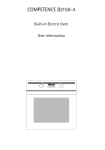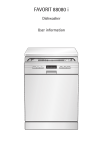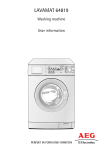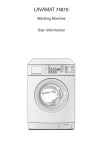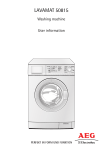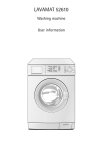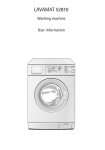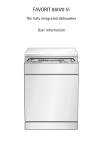Download Electrolux 41016VI User manual
Transcript
41016VI User manual Free standing electric cooker 2 Dear Customer Thank you for choosing one of our highquality products. With this appliance you will experience the perfect combination of functional design and cutting edge technology. Convince yourself that our appliances are engineered to deliver the best per formance and control indeed we are setting the highest standards of excel lence. In addition to this you find environmental and energy saving aspects as an inte gral part of our products. To ensure optimal and regular performance of your appliance please read this instruction manual carefully. It will enable you to navigate all processes perfect ly and most efficiently. To refer to this manual any time you need to, we recommend you to keep it in a safe place. And please pass it to any future owner of the appliance. We wish you much joy with your new appliance. 3 The following symbols are used in this user manual: Important information concerning your personal safety and information on how to avoid damaging the appliance. General information and tips 2 Environmental information 1 Contents 3 Contents Operating Instructions 5 Safety instructions 5 Description of the Appliance General Overview Control Panel Cooking surface Oven Features Oven accessories Before Using for the first time Setting and changing the time Initial Cleaning Operating the hob Setting the heat setting Switching on the dual fry/cook area Residual heat indicator Using the Oven Switching the Oven On and Off Oven Functions Inserting the Oven Shelf, Baking Tray and Roasting Pan Inserting/Removing the Grease Filter Clock Functions Switching Off the Time Display Uses, Tables and Tips Pans Cooking table Baking Baking table Table for Bakes and Gratins Frozen Ready Meals Table Roasting Roasting table Grill Sizes Grilling table Defrosting Defrosting table Drying Making Preserves 7 7 8 9 10 10 11 11 12 12 13 14 14 14 15 15 16 18 18 19 24 24 24 26 27 31 32 32 33 34 35 35 35 36 36 4 Contents Cleaning and Care Outside of the appliance Cooking surface Hob Frame Oven interior Accessories Fat Filter Shelf Support Rails Oven Lighting Oven Ceiling Oven door Oven door glass Pan drawer What to do if … 37 38 38 39 39 39 39 39 40 41 42 44 47 48 Disposal 49 Instruction on setting up Setting up Making the appliance level Safety information for the installer Guarantee/Customer Service 50 50 50 50 52 Service 58 Operating Instructions 5 Operating Instructions 1 Safety instructions 5 This appliance conforms with the following EU Directives: – 73/23/EEC dated 19.02.1973 Low Voltage Directive – 89/336/EEC dated 03.05.1989 EMC Directive inclusive of Amending Directive 92/31/EEC – 93/68/EEC dated 22.07.1993 CE Marking Directive Electrical safety • This appliance must be only connected by a registered electrician. • In the event of a fault or damage to the appliance: Take the fuses out or switch off. • Repairs to the appliance must only be carried out by qualified service engi neers. Considerable danger may result from improper repairs. If repairs be come necessary, please contact our Customer Services or your dealer. Child Safety • Never leave children unsupervised when the appliance is in use. Safety whilst Using • This appliance is intended to be used for cooking, roasting and baking food in the home. • Take care when connecting electric appliances to sockets nearby. Do not allow connecting leads to come into contact with or to catch beneath the hot oven door. • Warning: Risk of burns! The interior of the oven becomes hot during use. • Using ingredients containing alcohol in the oven may create an alcoholair mixture that is easily ignited. In this case, open the door carefully. Do not have embers, sparks or naked flames in the vicinity when opening the door. 3 Information on acrylamides According to the latest scientific knowledge, intensive browning of food, espe cially in products containing starch, can constitute a health risk due to acryla mides. Therefore we recommend cooking at the lowest possible temperatures and not browning foods too much. 6 Safety instructions How to avoid damage to the appliance • Do not line the oven with aluminium foil and do not place baking trays, pots, etc. on the oven floor, as the heat that builds up will damage the oven enamel. • Fruit juices dripping from the baking tray will leave stains, which you will not be able to remove. For very moist cakes, use a deep tray. • Do not put any strain on the oven door when open. • Never pour water directly into the oven when it is hot. This could cause dam age to or discoloration of the enamel. • Rough handling, especially around the edges of the front panel, can cause the glass to break. • Do not store any flammable materials inside the oven. These could ignite when the oven is switched on. • Do not store any moist foods inside the oven. This could damage the oven enamel. • After switching off the cooling fan, do not keep uncovered dishes in the oven. Moisture may condense in the oven interior or on the glass doors and may get into the units. 3 Note on enamel coating Changes in the colour of the oven’s enamel coating as a result of use do not af fect the appliance’s suitability for normal and correct use. They therefore do not constitute a defect in the sense of the warranty law. Description of the Appliance Description of the Appliance General Overview Control panel Door handle Full glass door Pan drawer 7 8 Description of the Appliance Control Panel Oven Power Indicator Temperature Pilot Light Time display Clock function buttons Oven Functions Hob Cooking Zone Control Knobs Temperature selector Hob Cooking Zone Control Knobs Description of the Appliance 9 Cooking surface Single cooking zone 1200W Double ring cooking zone 2200W Oven steam outlet Residual heat indicator Multipurpose zone 2300W Single cooking zone 1200W 10 Description of the Appliance Oven Features Top heat and heating elements Oven lighting Shelf positions Fat Filter Fan heating element Fan Bottom Heat Oven shelf runners, removable Oven accessories Oven shelf For cookware, cake tins, roasts and grilled foods. Baking tray For cakes and biscuits. Before Using for the first time Roasting Pan For baking and roasting or as a pan for col lecting fat. Before Using for the first time Setting and changing the time 3 The oven only operates when the time has been set. When the appliance has been connected to the electrical supply or when there has been a power cut, the function indicator Time flashes automatically. 1. To change a time that has already been set, press the Selection button repeatedly until the function indicator Time flashes. 2. Using the time. or button, set the current 11 12 Operating the hob After approx. 5 seconds, the flashing stops and the clock displays the time set. 3 The appliance is now ready to use. The time can only be changed if no auto matic function (Cook time or End time ) has been set. Initial Cleaning 1 3 You should clean the appliance thoroughly before using for the first time. Wipe the glass ceramic cooking surface with a damp cloth. Attention: Do not use sharp or abrasive cleaning materials. These could damage the surface. For appliances with metal fronts, use normal commercially available cleaning agents. 1. Turn the oven functions dial to Light . 2. Remove all accessories and the side rails and clean with warm water and wash ingup liquid. 3. Wash the oven in the same way, with warm water and washingup liquid, and dry it. 4. Wipe the front of the appliance with a damp cloth. Operating the hob 3 When a cooking zone is switched on, it may hum briefly. This is a characteristic of all ceramic glass cooking zones and does not impair either the function or the life of the appliance. Heat settings • Heat settings can be set from 19. • Intermediate positions are possible for settings 27. 1 = lowest output 9 = highest output = double ring switching Operating the hob 2 Switch the cooking zone off approx. 510 minutes before cooking is finished to make use of the residual heat. This saves electricity. front left rear left rear right Hob Cooking Zone Control Knobs 3 13 The cooker has popup ring switches. Press the ring switch to use it. The switch will then pop up. Setting the heat setting 1. Select the heat setting. 2. To end the cooking process, turn back to the Off position. front right 14 Using the Oven Switching on the dual fry/cook area 1 3 The control for the dual fry/cook area is switched on by turning to the right, and cannot be turned past the stop! 1. Turn the dual fry/cook control to the right. Continue turning to Position 9, and onto the symbol (you will feel a slight resistance). The stop position will then be clearly detect able. 2. Finally, turn back to the desired setting. 3. After cooking, turn back to the OFF position. To use the dual fry/cook area again afterwards, the larger ring must be switched back on. Residual heat indicator 1 2 The residual heat indicator lights up, as soon as the corresponding cooking zone is hot. Danger! Risk of burns from residual heat. After being switched off, the cooking zones need some time to cool down. Look at the residual heat indicator. Residual heat can be used for melting and keeping food warm. Using the Oven 3 The oven is equipped with retractable buttons for “Oven functions” and “Tem perature selection”. To use, press the relevant button. The button then sticks out. Using the Oven 15 Switching the Oven On and Off Oven Power Indicator Oven Functions Temperature Pilot Light Temperature selector 1. Turn the oven functions dial to the desired function. 2. Turn the temperature selector to the desired temperature. The power indicator is lit as long as the oven is in operation. The temperature pilot light is lit as long as the oven is heating up. 3. To turn the oven off, turn the oven functions dial and the temperature selector to the Off position. 3 Cooling fan The fan switches on automatically in order to keep the appliance’s surfaces cool. When the oven is switched off, the fan continues to run to cool the appliance down, then switches itself off automatically. Oven Functions The oven has the following functions: 16 Using the Oven Oven function Application Heating element/fan Light Using this function you can light up the oven interior, e.g. for cleaning. Fan cooking For baking on up to three oven lev Rear heating element, els at the same time. fan Set the oven temperatures 2040 °C lower than when using Conventional. Al Gusto Hot air For baking on one oven level dishes that require more intensive brown ing and a crispy base. Set the oven temperatures 2040 °C lower than when using Conventional. Conventional For baking and roasting on one oven Top heat, bottomheat level. Bottom heat For baking cakes with crispy or crusty bases. Defrost For defrosting e. g. flans and gateaux, Fan butter, bread, fruit or other frozen foods. Grill For grilling flat foodstuffs placed in Grill the middle of the grill and for toast ing. Dual gril For grilling flat foodstuffs in large quantities and for toasting. Rotitherm For roasting larger joints of meat or Grill, top heat, fan poultry on one level. The function is also suitable for grati nating and browning. Bottom heat, rear wall heating element, fan Bottom heat Grill, top heat Inserting the Oven Shelf, Baking Tray and Roasting Pan 3 Shelf runner safety and antitip device As a shelf runner safety device, all insertable components have a small curved indentation at the bottom on the right and lefthand edge. Always insert insertable components so that this indentation is at the back of the oven interior. This indentation is also important for preventing the insertable components from tipping. Using the Oven Inserting the baking tray or roasting pan Push the baking tray or roasting pan be tween the guide bars of the selected oven level. 3 Inserting the oven shelf: Insert the oven shelf so that the feet point downwards. Push the oven shelf between the guide bars of the selected oven level. The high rim around the oven shelf is an additional device to prevent cookware from slipping. Inserting the oven shelf and roasting pan together Lay the oven shelf on the roasting pan. Push the roasting pan between the guide bars of the selected oven level. 17 18 Using the Oven Inserting/Removing the Grease Filter Only use the grease filter when roasting to protect the rear heating elements from fat splashes. Inserting the grease filter Hold the grease filter by the grip and insert the two mounts down wards into the opening on the rear wall of the oven (fan opening). Taking out the grease filter Hold the grease filter by the grip and unhook it. Clock Functions Function Indicators Button Time display Function Indicators Selector Button Countdown To set a countdown. A signal sounds after the time has elapsed. This function does not affect the functioning of the oven. Cook time To set how long the oven is to be in use. Button Using the Oven 19 End time To set when the oven is to switch off again. Time To set, change or check the time (See also section “Before Using for the First Time”). 3 How to use the clock functions • After a function has been selected, the corresponding function indicator flashes for about 5 seconds. During this period, the desired times can be set using the or button. • When the desired time has been set, the function indicator continues to flash for approx. 5 seconds. After that the function indicator is then lit. The set time begins to run. • Press any of the buttons to stop the audible signal. • The desired oven function and temperature can be selected before or after the clock functions Cook time and End time are set. • When the cooking process is completed, turn the oven function dial and the temperature selector back to the OFF position. 2 3 Switching Off the Time Display By switching off the time display you can save energy. Switching off the time display Press and hold down any two buttons until the display becomes dark. Switching on the time display Hold down any button until the time reappears in the display. The display can only be switched off if none of the clock functions Cook time End time or Countdown is in use. Countdown 1. Press the Selection button repeatedly until the function indicator Countdown flashes. , 20 Using the Oven 2. Using the or button set the desired Countdown (max. 2 hours 30 minutes). After approx. 5 seconds the display shows the time remaining. The function indicator Countdown lights up. When the time has elapsed, the function indicator flashes and an audible signal sounds for 2 minutes. The signal can be stopped by pressing any button. Using the Oven Cook time 1. Press the Selection button repeatedly until the function indicator Cook time flashes. 2. Using the or cooking time. button set the desired After approx. 5 seconds the display returns to showing the current time. The function indicator Cook time lights up. When the time has elapsed, the function indicator flashes, an audible signal sounds for 2 minutes and the oven switches itself off. 3. The signal and the programme can be stopped by pressing any button. 21 22 Using the Oven End time 1. Press the Selection button repeatedly until the function indicator End time flashes. 2. Using the or switchoff time. button set the desired After approx. 5 seconds the display returns to showing the current time. The function indicator End time lights up. When the time has elapsed, the function indicator flashes, an audible signal sounds for 2 minutes and the oven switches itself off. 3. The signal and the programme can be stopped by pressing any button. Using the Oven 3 Cook time and End time 23 combined Cook time and End time can be used simultaneously, if the oven is to be switched on and off automatically at a later time. 1. Using the Cook time function, set the time required for cooking the dish. In this example, 1 hour. 2. Using the End time function, set the time at which the dish should be ready. In this case 14:05:00. The function indicators Cook time and End time light up and the current time is shown in the display. In this case 12:05. The oven switches on automatically at the time calculated. In this case, at 13:05:00. And switches itself off again when the cooking time entered has elapsed. In this case, at 14:05. 24 Uses, Tables and Tips Uses, Tables and Tips Pans • You can recognise good pans by their bases. The base should be as thick and flat as possible. • Pay particular attention when buying new pans to the diameter of the base. Manufacturers often give only the diameter of the upper rim. • Pots with aluminium or copper bases can cause metallic discolouring on the ceramic glass surface, which is very difficult or impossible to remove. • Do not use cast iron pans or pans with a rough, burred or damaged base. This can produce permanent scratching if the pan is slid across the surface. • When cold, pan bases are normally bowed slightly inwards (concave). They should never be bowed outwards (con vex). • If you wish to use special types of pan (e.g. a pressure cooker, simmering pan, wok, etc.), please observe the manufac turer's instructions. 2 Energy saving tips • Always position pots and pans before switching on the cooking zone. • Whenever possible always position the lids firmly on pots and pans to cover completely. • Switch off the cooking zones before the end of the cooking time to use the resid ual heat such as to keep foods warm or for melting. • The base of the pan should be the same size as the cooking zone. Cooking table The information given in the following table is for guidance only. Uses, Tables and Tips Heat setting Cooking process suitable for 0 Residual heat, Off position 1 Keeping Keeping cooked foods warm food warm 12 Melting Hollandaise sauce, melting butter, chocolate, gelatine Solidifying Fluffy omelettes, baked eggs 1 Tips/Hints as required Cover 525 mins. Stir occasionally 1040 mins. Cook with lid on 23 Simmer ing on low heat Simmering rice and milk based dishes Heating up readycooked meals 2550 mins. Add at least twice as much liquid as rice, stir milk dishes part way through cooking 34 Steaming Braising Steaming vegetables, fish braising meat 2045 mins. With vegetables add only a little liquid (a few table spoons) Steaming potatoes 2060 mins. Use only a little liquid, e. g.: max. ¼ l water for 750 g potatoes Cooking larger quantities of food, stews and soups 60150 mins. Up to 3 l liquid plus in gredients 67 Gentle Frying Frying escalopes, veal cor don bleu, cutlets, rissoles, sausages, liver, roux, eggs, pancakes, doughnuts Steady frying Turn halfway through cooking 78 Heavy Frying Hash browns, loin steaks, steaks, Flädle (pancakes for garnishing soup) 515 mins. per pan Turn halfway through cooking 9 Boiling Searing Deep frying Boiling large quantities of water, cooking pasta, searing meat (goulash, pot roast), deep frying chips 45 3 Cooking time 25 Boiling We recommend when boiling or searing foods using the highest heat setting at first and then letting foods requiring a longer cooking time finish cooking on the desired heat setting. Overheated fats and oils can ignite quickly. If you are cooking foods in fat or oil (e.g. chips), remain nearby. 26 Uses, Tables and Tips Baking Oven function: Fan cooking or Conventional Baking tins • For Conventional dark metal and nonstick tins are suitable. • For Fan cooking bright metal tins are also suitable. Oven levels • Baking with Conventional is possible on one oven level. • With Fan cooking you can bake on up to 3 baking trays at the same time: 1 baking tray: e.g. oven level 3 1 cake tin: e.g. oven level 1 2 baking trays: z. g., oven levels 1 and 3 3 baking trays: oven levels 1, 3 and 5 General Instructions • Insert the tray with the bevel at the front. • With Conventional or Fan cooking you can also bake with two tins next to one another on the oven shelf at the same time. This does not significantly increase baking time. Uses, Tables and Tips 3 2 27 When frozen foods are used the trays inserted may distort during cooking. This is due to the large difference in temperature between the freezing temperature and the temperature in the oven. Once the trays have cooled the distortion will disappear again. How to use the Baking Tables The tables give the required temperature settings, baking times and oven shelf levels for a selection of typical dishes. • Temperatures and baking times are for guidance only, as these will depend on the consistency of pastry, dough or mixture, the amount and the type of bak ing tin. • We recommend using the lower temperature the first time and then if neces sary, for example, if a deeper browning is required, or baking time is too long, selecting a higher temperature. • If you cannot find the settings for a particular recipe, look for the one that is most similar. • If baking cakes on baking trays or in tins on more than one level, baking time may be extended by 1015 minutes. • Moist recipes (for example, pizzas, fruit flans, etc.) are baked on one level. • Cakes and pastries at different heights may brown at an uneven rate at first. If this occurs, please do not change the temperature setting. Different rates of browning even out as baking progresses. • Your new oven may bake or roast differently to your previous appliance. So adapt your normal settings (temperature, cooking times) and oven shelf levels to the recommendations in the following tables. With longer baking times, the oven can be switched off about 10 minutes before the end of baking time, to make use of the residual heat. Unless otherwise stated, the values given in the tables assume that cooking is started with the oven cold. Baking table Baking on one oven level Type of baking Oven function Oven level Temperature °C Time Hr: Mins. Baking in tins Ring cake or brioche Fan cooking 1 150160 0:501:10 Madeira cake/fruit cakes Fan cooking 1 140160 1:101:30 Sponge cake Fan cooking 1 140 0:250:40 Sponge cake Conventional 1 160 0:250:40 28 Uses, Tables and Tips Type of baking Oven function Oven level Temperature °C Time Hr: Mins. Flan base short pastry Fan cooking 3 1701801) 0:100:25 Flan base sponge mixture Fan cooking 3 150170 0:200:25 Apple pie Conventional 1 170190 0:501:00 Apple pie (2tins Ø20cm, diagonally off set) Fan cooking 1 160 1:101:30 Apple pie (2tins Ø20cm, diagonally off set) Conventional 1 180 1:101:30 Savoury flan (e. g, quiche lorraine) Fan cooking 1 160180 0:301:10 Cheesecake Conventional 1 170190 1:001:30 3 170190 0:300:40 Cakes/pastries/breads on baking trays Plaited bread/bread crown Conventional Christmas stollen Conventional 3 Bread (rye bread) first of all then Conventional 1 Cream puffs/eclairs Conventional Swiss roll 1) 160180 0:401:00 2301) 160180 0:25 0:301:00 3 1601701) 0:150:30 Conventional 3 1802001) 0:100:20 Cake with crumble topping (dry) Fan cooking 3 150160 0:200:40 Buttered almond cake/sugar cakes Conventional 3 1902101) 0:150:30 Fruit flans (made with yeast dough/ sponge mixture)2) Fan cooking 3 150 0:350:50 Fruit flans (made with yeast dough/ sponge mixture)2) Conventional 3 170 0:350:50 Fruit flans made with short pastry Fan cooking 3 160170 0:401:20 Yeast cakes with delicate toppings (e. g, quark, cream, custard) Conventional 3 1601801) 0:401:20 Pizza (with a lot of top ping)2) Fan cooking 1 1802001) 0:301:00 Pizza (thin crust) Fan cooking 1 2002201) 0:100:25 Unleavened bread Fan cooking 1 200220 0:080:15 Tarts (CH) Fan cooking 1 180200 0:350:50 Biscuits Uses, Tables and Tips Type of baking Oven function 29 Oven level Temperature °C Time Hr: Mins. Short pastry biscuits Fan cooking 3 150160 0:060:20 Viennese whirls Fan cooking 3 140 0:200:30 1) Viennese whirls Conventional 3 160 0:200:30 Biscuits made with sponge mixture Fan cooking 3 150160 0:150:20 Pastries made with egg white, meringues Fan cooking 3 80100 2:002:30 Macaroons Fan cooking 3 100120 0:300:60 Biscuits made with yeast dough Fan cooking 3 150160 0:200:40 Puff pastries Fan cooking 3 1701801) 0:200:30 Rolls Fan cooking 3 1601) 0:200:35 1) Rolls Conventional 3 180 0:200:35 Small cakes (20per tray) Fan cooking 3 1401) 0:200:30 3 1) 0:200:30 Small cakes (20per tray) Conventional 170 1) Preheat the oven 2) Use the drip tray or roasting tray Baking on more than one oven level Fan cooking Type of baking Fan cooking Shelf positions from bottom 2 levels Temperature in °C Time Hours: Mins. 3 levels Cakes/pastries/breads on baking trays Cream puffs/Eclairs 1/4 1601801)) 0:350:60 Dry streusel cake 1/3 140160 0:300:60 Biscuits/small cakes/pastries/rolls Short pastry biscuits 1/3 1/3/5 150160 0:150:35 Viennese whirls 1/3 1/3/5 140 0:200:60 Biscuits made with sponge mixture 1/3 160170 0:250:40 Biscuits made with egg white, meringues 1/3 80100 2:102:50 Macaroons 1/3 100120 0:401:20 Biscuits made with yeast dough 1/3 160170 0:300:60 30 Uses, Tables and Tips Fan cooking Type of baking Fan cooking Shelf positions from bottom Temperature in °C Time Hours: Mins. 1701801) 0:300:50 2 levels 3 levels Puff pastries 1/3 Rolls 1/4 160 0:300:55 Small cakes (20per tray) 1/4 1401) 0:250:40 1) Preheat the oven Tips on Baking Baking results Possible cause Remedy The cake is not browned enough underneath Wrong oven level Place cake lower The cake sinks (becomes soggy, lumpy, streaky) Oven temperature too high Use a slightly lower setting Baking time too short Set a longer baking time Baking times cannot be re duced by setting higher tem peratures Too much liquid in the mixture Use less liquid. Pay attention to mixing times, especially if using mixing ma chines Oven temperature too low Set oven temperature higher. Baking time too long Set a shorter baking time Oven temperature too high and baking time too short Set a lower oven temperature and a longer baking time Mixture is unevenly distributed Spread the mixture evenly on the baking tray Grease filter is inserted Take out the grease filter Cake is too dry Cake browns unevenly Cake does not cook in the Temperature too low baking time given Grease filter is inserted Use a slightly higher oven set ting Take out the grease filter Uses, Tables and Tips 31 Table Al Gusto Hot air Shelf position Temperature °C Time Hr: Mins. Pizza (thin crust) 1 180 2001) 20 30 Pizza (with a lot of topping) 1 180 200 20 30 Tarts 1 180 200 45 60 Spinach flan 1 160 180 45 60 Quiche Lorraine 1 170 190 40 50 Quark flan, round 1 140 160 60 90 Quark flan on tray 1 140 160 50 60 Apple cake, covered 1 150 170 50 70 Vegetable pie 1 160 180 50 60 Unleavened bread 1 250 2701) 10 20 Puff pastry flan 1 160 1801) 40 50 Flammekuchen (Pizzalike dish from Alsace) 1 250 2701) 12 20 Piroggen (Russian version of cal zone) 1 180 2001) 15 25 Type of baking 1) Preheat the oven Table for Bakes and Gratins Dish Oven function Shelf position Temperature °C Time Hr: Mins. Pasta bake Conventional 1 180200 0:451:00 Lasagne Conventional 1 180200 0:250:40 Vegetables au gratin1) Fan cooking 1 160170 0:150:30 Baguettes topped with melted cheese1) Fan cooking 1 160170 0:150:30 Sweet bakes Conventional 1 180200 0:400:60 Fish bakes Conventional 1 180200 0:301:00 Stuffed vegetables Fan cooking 1 160170 0:301:00 1) Preheat the oven 32 Uses, Tables and Tips Frozen Ready Meals Table Food to be cooked Oven function Shelf position Temperature °C Time Frozen pizza Conventional 3 as per manufac turer’s instruc tions as per manufac turer’s instruc tions Chips1) (500 g) Fan cooking 3 200220 as per manufac turer’s instruc tions Baguettes Conventional 3 as per manufac turer’s instruc tions as per manufac turer’s instruc tions Fruit flans Conventional 3 as per manufac turer’s instruc tions as per manufac turer’s instruc tions 1) Comments: Turn chips 2 or 3 times during cooking Roasting Oven function: Conventional or Rotitherm Roasting dishes • Any heatresistant ovenware is suitable to use for roasting (please read the manufacturer's instructions). • Large roasting joints can be roasted directly in the roasting tray or on the oven shelf with the roasting tray placed below it. • For all lean meats, we recommend roasting these in a roasting tin with a lid. This will keep the meat more succulent. • All types of meat, that can be browned or have crackling, can be roasted in the roasting tin without the lid. 3 Tips on using the roasting chart The information given in the following table is for guidance only. • We recommend cooking meat and fish weighing 1 kg and above in the ov en. • To prevent escaping meat juices or fat from burning on to the pan, we recom mend placing some liquid in the roasting pan. • If required, turn the roast (after 1/2 2/3 of the cooking time). Uses, Tables and Tips 33 • Baste large roasts and poultry with their juices several times during roasting. This will give better roasting results. • You can switch the oven off about 10 minutes before the end of the roasting time, in order to utilise the residual heat. Roasting table Type of meat Quantity Ovenfunction Shelf position Tempera Time ture Hours mins. °C Beef Pot roast 11.5 kg Convention al 1 200250 2:002:30 per cm. of thickness Roast beef or fillet rare per cm. of thickness Rotitherm 1 1902001) 0:050:06 medium per cm. of thickness Rotitherm 1 180190 0:060:08 well done per cm. of thickness Rotitherm 1 170180 0:080:10 Shoulder, neck, ham joint 11.5 kg Rotitherm 1 160180 1:302:00 Chop, spare rib 11.5 kg Rotitherm 1 170180 1:001:30 Meat loaf 750 g1 kg Rotitherm 1 160170 0:451:00 Porkknuckle (pre cooked) 750 g1 kg Rotitherm 1 150170 1:302:00 Pork Veal Roast veal 1 kg Rotitherm 1 160180 1:302:00 1.52 kg Rotitherm 1 160180 2:002:30 Leg of lamb, roast lamb 11.5 kg Rotitherm 1 150170 1:152:00 Saddle of lamb 11.5 kg Rotitherm 1 160180 1:001:30 up to 1 kg Convention al 3 2202501) 0:250:40 1.52 kg Convention al 1 210220 1:151:45 Knuckle of veal Lamb Game Saddle of hare, leg of hare Saddle of venison 34 Uses, Tables and Tips Ovenfunction Shelf position Tempera Time ture Hours mins. °C Type of meat Quantity Haunch of venison 1.52 kg Convention al 1 200210 1:302:15 Poultry portions 200250g each Rotitherm 1 200220 0:350:50 Half chicken 400500g each Rotitherm 1 190210 0:350:50 Chicken, poulard 11.5 kg Rotitherm 1 190210 0:451:15 Duck 1.52 kg Rotitherm 1 180200 1:151:45 Goose 3.55 kg Rotitherm 1 160180 2:303:30 Turkey 2.53.5 kg Rotitherm 1 160180 1:452:30 Turkey 46 kg Rotitherm 1 140160 2:304:00 11.5 kg Convention al 1 210220 0:451:15 Poultry Fish (steamed) Whole fish 1) Preheat the oven Grill Sizes 1 3 Oven function: Grill or Dual gril with maximum temperature setting Important: Always grill with the oven door closed. The empty oven should always be preheated with the grill functions for 5 minutes. • For grilling, place the shelf in the recommended shelf position. • Always insert the tray for collecting the fat into the first shelf position from the bottom. • The grilling times are guidelines. • Grilling is particularly suitable for flat pieces of meat or fish. Uses, Tables and Tips 35 Grilling table Grilling time Food to be grilled Oven level 1st side 2nd side Burgers 4 810 mins. 68 mins. Pork fillet 4 1012 mins. 610 mins. Sausages 4 810 mins. 68 mins. Fillet steaks, veal steaks 4 67 mins. 56 mins. Fillet of beef, roast beef (approx. 1 kg) 3 1012 mins. 1012 mins. 3 46 mins. 35 mins. 3 68 mins. Toast 1) Toast with topping 1) Do not preheat Defrosting Oven function: Defrost (no temperature setting) • Unwrap the food and place it on a plate on the oven shelf. • Do not cover with a plate or bowl, as these can substantially lengthen the de frosting time. • For defrosting, place the shelf in the 1st oven level from the bottom. Defrosting table Defrosting time mins. Further defrosting time (mins.) Chicken, 1000 g 100140 2030 Place the chicken on an upturned saucer placed on a large plate Turn halfway through Meat, 1000 g 100140 2030 Turn halfway through Meat, 500 g 90120 2030 Turn halfway through Trout, 150g 2535 1015 Strawberries, 300g 3040 1020 Butter, 250g 3040 1015 Cream, 2 x 200g 80100 1015 Cream can also be whipped when still slightly frozen in places Gateau, 1400g 60 60 Dish Comments 36 Uses, Tables and Tips Drying Oven function: Fan cooking • Use oven shelves covered with greaseproof paper or baking parchment. • You get a better result if you switch the oven off halfway through the drying time, open the door and leave the oven to cool down overnight. • After this finish drying the food to be dried. Oven level Temperature in °C 1 level 2 levels Time in hours (Guideline) Beans 6070 3 1/4 68 Peppers (strips) 6070 3 1/4 56 Vegetables for soup 6070 3 1/4 56 Mushrooms 5060 3 1/4 68 Herbs 4050 3 1/4 23 Plums 6070 3 1/4 810 Apricots 6070 3 1/4 810 Apple slices 6070 3 1/4 68 Pears 6070 3 1/4 69 Food to be dried Vegetables Fruit Making Preserves Oven function: Bottom heat • For preserving, use only commercially available preserve jars of the same size. • Jars with twistoff or bayonet type lids and metal tins are not suitable. • When making preserves, the first shelf position from the bottom is the one most used. • Use the shelf for making preserves. There is enough room on this for up to six 1litre preserving jars. • The jars should all be filled to the same level and clamped shut. • Place the jars on the baking tray in such a way that they are not touching each other. Cleaning and Care 37 • Pour approx. 1/2 litre of water into the baking tray so that sufficient moisture is produced in the oven. • As soon as the liquid starts to pearl in the first jars (after about 3560 minutes with 1 litre jars), switch the oven off or reduce the temperature to 100°C (see table). Preserves table The times and temperatures for making preserves are for guidance only. Temperature in°C Cooking time until simmering in mins. Continue to cook at 100°C in mins. Strawberries, blueberries, rasp berries, ripe gooseberries 160170 3545 Unripe gooseberries 160170 3545 1015 160170 3545 1015 160170 5060 510 Preserve Soft fruit Stone fruit Pears, quinces, plums Vegetables Carrots1) Mushrooms 1) 160170 4060 1015 Cucumbers 160170 5060 Mixed pickles 160170 5060 15 Kohlrabi, peas, asparagus 160170 5060 1520 Beans 160170 5060 1) Leave standing in oven when switched off Cleaning and Care 1 Warning: For cleaning, the appliance must be switched off and cooled down. Warning: For safety reasons, do not clean the appliance with steam jet or high pressure cleaning equipment. Attention: Do not use any scouring agents, sharp cleaning tools or scour ers. 38 Cleaning and Care Outside of the appliance • Wipe the front of the appliance with a soft cloth and warm water and wash ing up liquid. • For metal fronts, use normal commercially available cleaning agents. Cooking surface 1 3 Important: Cleaning agents must not be used on hot glass ceramic surfaces. All cleaning agents must be removed with plenty of clean water, as they can have a corrosive effect when the cooking surface is heated up. Only clean when the surface is cold. Do not use any aggressive cleaning materials, such as grill or oven sprays, rough scouring agents or scratchy pan cleaners. Clean the glass ceramic cooking surface after every use, when it is handhot or cold. This prevents food residues from being burnt on. Limestone and water rings, fat splashes and shiny metallic discolorations can be removed with a standard commercially available cleaner for glass ceramic or stainless steel. Follow the manufacturer’s instructions. Light soiling 1. Wipe glass ceramic surface with a damp cloth and a little washing up liquid. 2. Then rub dry using a clean cloth. No cleaning agent residues must remain on the surface. Stubborn residues 3 1 1 1. Use a scraper to remove foods that have boiled over or stubborn splashes. 2. Place the scraper on the glass ceramic surface at an angle. 3. Remove residues by sliding the blade over the surface. You can get scrapers and glass ceramic cleaners from specialist shops. Special residues 1. Remove burnt on sugar, melted plastic, tin foil or other materials that melt im mediately, while still hot with a scraper. Attention: There is a risk of burns when using the scraper on the hot cooking zone. 2. Then clean the cooking surface in the normal way when it has cooled down. Cleaning and Care 3 39 If the cooking zone that has the melted materials on it has already cooled down, heat it up again before cleaning it. Scratches or dark stains on the glass ceramic surface, that have been made e. g. by pot and pan bottoms with sharp edges, cannot be removed. However they do not affect the cooking surface’s ability to function. Hob Frame 1 Important! Do not put vinegar, lemonjuice or scale removers on the hob frame, otherwise dull spots will appear. 1. Wipe the frame with a damp cloth and a little washing up liquid. 2. Soften dried dirt with a wet cloth. Then wipe off and rub dry. Oven interior 3 1 Clean the appliance after each use. In this way, dirt is easier to clean off and is not allowed to burn on. 1. For cleaning, turn the oven light on. 2. After every use, wipe the oven with a solution of washingup liquid and allow to dry. Clean stubborn dirt with a special oven cleaner. Important: If using an oven spray, please follow the manufacturer's instructions exactly. Accessories Wash all slidein units (shelf unit, baking tray, shelf support rails etc.) after each use and dry well. Soak briefly to make them easier to clean. Fat Filter 1. Clean the fat filter in hot water and washing up liquid or in the dishwasher. 2. Badly burned on soiling can be removed by boiling the filter in a little water to which 23 tablespoonsful of dishwasher cleaner has been added. Shelf Support Rails The shelf support rails on the left and right hand sides of the oven can be re moved for cleaning the side walls. 40 Cleaning and Care Removing the shelf support rails First pull the front of the rail away from the oven wall (1) and then unhitch at the back (2). 3 Fitting the shelf support rails Important! The rounded ends of the guide rails must be pointing forwards! To reinsert, first hook the rail into place at the back (1) and then insert the front and press into place (2). Oven Lighting 1 3 Warning: Risk of electric shock! Prior to changing the oven light bulb: – Switch off the oven! – Disconnect from the electricity supply. Place a cloth on the oven floor to protect the oven light and glass cover. Cleaning and Care 41 Changing the oven light bulb/cleaning the glass cover 1. Remove the glass cover by turning it anti clockwise and then clean it. 2. If necessary: replace with 25 watt, 230 V, 300 °C heatresistant oven lighting. 3. Refit the glass cover. Oven Ceiling 1 1 The upper heating element can be folded down to make it easier to clean the oven ceiling. Folding down the heating element Warning: Only fold down the heating ele ment when the oven is switched off and there is no risk of being burnt! 1. Remove the side shelf support rails. 2. Grip the heating element at the front and pull it forwards and out over the support lug on the inner wall of the oven. 3. The heating element will now fold down. Caution: Do not use force to press the heating element down! The heating ele ment might break. Cleaning the oven ceiling 42 Cleaning and Care 1. 2. 1 3. 4. Repositioning the heating element Move the heating element back up towards the oven ceiling. Pull the heating element forwards against the spring pressure and guide it over the oven support lug. Settle it onto the support. Insert shelf support rail. Important: The heating element must be positioned correctly and securely on both sides above the support lug on the inner wall of the oven. Oven door For easier cleaning of the oven interior the oven door of your appliance can be taken off its hinges. Removing the oven door from its hinges 1. Open the oven door as far as it will go. 2. Undo the clamping levers (A) on both door hinges fully. Cleaning and Care 3. Close the oven door as far as the first posi tion (approx. 45°). 3 4. Take hold of the oven door with a hand on each side and pull it away from the oven at an upwards angle (Take care: It is heavy). Lay the oven door with the outer side fac ing downwards on something soft and lev el, for example, a blanket in order to prevent scratches. Hanging the oven door back on its hinges 1. From the handle side take hold of the oven door with a hand on each side and hold at an angle of approx. 45°. Position the recesses on the bottom of the oven door on the hinges on the oven. Let the door slide down as far as it will go. 2. Open the oven door as far as it will go. 43 44 Cleaning and Care 3. Fold up the clamping levers (A) on both door hinges back into their original positions. 4. Close the oven door. Oven door glass 1 The oven door is fitted with two panels of glass mounted one behind the other. The inner panel can be removed for cleaning. Important Rough handling, especially around the edges of the front panel, can cause the glass to break. Removing the door glass 1. Open the oven door as far as it will go. 2. Undo the clamping levers (A) on both door hinges fully. Cleaning and Care 45 3. Close the oven door as far as the first posi tion (approx. 45°). 4. Take hold of the door trim (B) on the upper edge of the door at both sides and press in wards to release the clip seal. Then remove the door trim by pulling upwards. 5. Take hold of the door glass on its upper edge and take it out of the guide by pulling it upwards. Cleaning the door glass Clean the door glass thoroughly with a solution of water and washing up liquid. Then dry it carefully. Putting the door glass back 1. From above insert the door glass at an an gle into the door profile at the bottom edge of the door and lower it. 46 Cleaning and Care 2. Take hold of the door trim (B) at each side, position it on the inside edge of the door and plug the door trim(B) into the upper edge of the door. 3 On the open side of the door trim (B) there is a guide bar (C). This must be pushed be tween the outer door panel and the guide corner(D). The clip seal (E) must be snapped in. 3. Open the oven door as far as it will go. Cleaning and Care 4. Fold up the clamping levers (A) on both door hinges back into their original positions. 5. Close the oven door. Pan drawer The pan drawer underneath the oven can be removed for easier cleaning. Removing / Replacing the pan drawer 1. Pull the pan drawer out of the cooker as far as possible. 2. Lift the pan drawer slightly, so that it can be lifted upwards at an angle out of the drawer guides. 47 48 1 What to do if … 3. When reinserting the drawer, make sure that the pan drawer’s middle guide enga ges into the middle guide rails. 4. Lower the pan drawer to the horizontal and push it in. Warning: When the oven is in use, heat can build up in the pan drawer. For this reason, do not keep flammable things in there such as e. g. cleaning materials, plas tic bags, oven gloves, paper, etc. On no account store oven cleaning sprays there! What to do if … Problem Possible cause Remedy The cooking zones are not functioning Consult the operating instructions for the builtin cooking sur face The oven does not heat up The oven is not switched on Switch the oven on The clock is not set Set the current time on the clock The required settings have not Check the settings been set The oven lighting is not oper ating 1 3 The house wiring fuse (in the fuse box) has tripped Check the fuse. If the fuses trip a number of times, please call an authorised electrician. The oven light bulb is faulty Replace the oven bulb If you are unable to remedy the problem by following the above sugges tions, please contact your dealer or the Customer Care Department. Warning! Repairs to the appliance are only to be carried out by qualified service engineers. Considerable danger to the user may result from improper repairs. If the appliance has been wrongly operated, the visit from the customer service technician or dealer may not take place free of charge, even during the warranty period. Disposal 3 49 Advice on cookers with metal fronts: Because of the cold surface at the front of the cooker, opening the oven door during (or just after) baking or roasting may cause the glass to steam up. Disposal 2 Packaging material The packaging materials are environmentally friendly and can be recycled. The plastic components are identified by markings, e.g. >PE<, >PS<, etc. Please dis pose of the packaging materials in the appropriate container at the community waste disposal facilities. 2 Old appliance W 1 The symbol on the product or on its packaging indicates that this product may not be treated as household waste. Instead it shall be handed over to the applicable collection point for the recycling of electrical and electronic equip ment. By ensuring this product is disposed of correctly, you will help prevent po tential negative consequences for the environment and human health, which could otherwise be caused by inappropriate waste handling of this product. For more detailed information about recycling of this product, please contact your local city office, your household waste disposal service or the shop where you purchased the product. Warning: So that the old appliance can no longer cause any danger, make it unusable before disposing of it. To do this, disconnect the appliance from the mains supply and remove the mains cable from the appliance. 50 Instruction on setting up Instruction on setting up 1 Important! The new appliance may only be installed and connected by quali fied personnel. Please observe this instruction, otherwise the warranty will not cover any dam age that may occur. Setting up • In the units or furniture surrounding the appliance, veneers or plastic coatings must have been made up using heatresistant bonding agents (100°C). If plas tic coatings or cements are not sufficiently heatresistant, the coating may be deformed or loosened. • The appliance may be installed up against tall units or walls on one side only. • The distance between the cooking surface and the cooker hood must as a minimum be as great as that indicated in the installation instructions for the cooker hood. • If the appliance is being placed on a base, measures must be taken to prevent the appliance from sliding off the base. Making the appliance level 3 1 Underneath the appliance there are 4 adjustable feet, which can be used to even out small unlevelnesses in the floor. 1. Remove the pan drawer. 2. Turn the adjustable feet to make them higher or lower as required, until the cook er is standing level. 3. Reinsert the pan drawer. The adjustable feet are easier to turn, if the cooker is tilted slightly to take the weight off the foot. Safety information for the installer • The setup of the electrical installation is arranged so that the appliance can be isolated from the mains with a minimum 3 mm allpole contact separation. Instruction on setting up 51 Suitable separation devices include e. g. cutouts, fuses (screw fuses are to be taken out of the holder), RCD’s and contactors. • Avoid installing the appliance next to doors and under windows. Otherwise hot cookware may be knocked off the rings when doors and windows are opened. • The appliance must be connected to the electricity according to the connec tion schematic on the outside of the terminal cover. • The cable which connects the appliance to the mains must correspond to in sulation standard H05VVF (=227 IEC 53) as a minimum. 52 Guarantee/Customer Service Guarantee/Customer Service Belgium DECLARATION OF GUARANTEE TERMS. Our appliances are produced with the greatest of care. However, a defect may still occur. Our consumer serv ices department will repair this upon request, either during or after the guarantee period. The service life of the appliance will not, however, be reduced as a result. This declaration of guarantee terms is based on European Union Directive 99/44/EC and the provisions of the Civil Code. The statutory rights that the consumer has under this legislation are not affected by this declara tion of guarantee terms. This declaration does not affect the vendor's statutory warranty to the end user. The appliance is guaranteed within the context of and in adherence with the following terms: 1. In accordance with provisions laid down in paragraphs 2 to 15, we will remedy free of charge any defect that occurs within 24 months from the date the appliance is delivered to the first end user. These guarantee terms do not apply in the event of use for professional or equivalent purposes. 2. Performing the guarantee means that the appliance is returned to the condition it was in before the defect oc curred. Defective parts are replaced or repaired. Parts replaced free of charge become our property. 3. So as to avoid more severe damage, the defect must be brought to our attention immediately. 4. Applying the guarantee is subject to the consumer providing proof of purchase showing the purchase and/or delivery date. 5. The guarantee will not apply if damage caused to delicate parts, such as glass (vitreous ceramic), synthetic ma terials and rubber, is the result of inappropriate use. 6. The guarantee cannot be called on for minor faults that do not affect the value or the overall reliability of the appliance. 7. The statutory warranty does not apply when defects are caused by: • a chemical or electrochemical reaction caused by water, • abnormal environmental conditions in general, • unsuitable operating conditions, • contact with harsh substances. 8. The guarantee does not apply to defects due to transport which have occurred outside of our responsibility. Nor will the guarantee cover those caused by inadequate installation or assembly, lack of maintenance or fail ure to respect the assembly instructions or directions for use. 9. Defects that result from repairs or measures carried out by people who are not qualified or expert or defects that result from the addition of nonoriginal accessories or spare parts are not covered by the guarantee. 10. Appliances that are easy to transport may be delivered or sent to the consumer services department. Home re pairs are only anticipated for bulky appliances or builtin appliances. 11. If the appliances are builtin, builtunder, fixed or suspended in such a way that removing and replacing them in the place where they are fitted takes more than half an hour, the costs that result therefrom will be charged for. Connected damage caused by these removal and replacement operations will be the responsibility of the user. 12. If, during the guarantee period, repairing the same defect repeatedly is not conclusive, or if the repair costs are considered disproportionate, in agreement with the consumer, the defective appliance may be replaced with another appliance of the same value. In this event, we reserve the right to ask for a financial contribution calculated according to the length of time it has been used. 13. A repair under guarantee does not mean that the normal guarantee period will be extended nor that a new guarantee period begins. 14. We give a twelve month guarantee for repairs, limited to the same defect. 15. Except in the event where liability is legally imposed, this declaration of guarantee terms excludes any com pensation for damage outside the appliance for which the consumer wishes to assert his rights. In the event of legally admitted liability, compensation will not exceed the purchase price paid for the appliance. These guarantee terms are only valid for appliances purchased and used in Belgium. For exported appliances, the user must first make sure that they satisfy the technical conditions (e.g.: voltage, frequency, installation in structions, type of gas, etc.) for the country concerned and that they can withstand the local climatic and en vironmental conditions. For appliances purchased abroad, the user must first ensure that they meet the Guarantee/Customer Service 53 qualifications required in Belgium. Nonessential or requested adjustments are not covered by the guarantee and are not possible in all cases. Our consumer services department is always at your disposal, even after the guarantee period has expired. Address for our consumer services department: ELECTROLUX HOME PRODUCTS BELGIUM Bergensesteenweg, 719 1502 LEMBEEK Tel.: 02.363.04.44 Weitere Kundendienststellen im Ausland In diesen Ländern gelten die Garantiebedingungen der örtlichen Partner. Diese können dort eingesehen werden. Further after-sales service agencies overseas In these countries our AEG-Electrolux agents’ own guarantee conditions are applicable. Please obtain further details direct. Autres agences étrangères assurant le service après-vente Dans ces pays, les conditions de garantie des concessionnaires de la région sont valables. Vous pouvez les consulter sur place. Otros puntos de Postventa en el extranjero En estos países rigen las condiciones de nuestros representantes locales. las cuales pueden ser consultadas allí mismo. Ulteriori uffici del servizio tecnico assistenza clienti all’estero In questi paesi sono valide le condizioni di garanzia dei partner locali. Queste condizioni possono essere esaminante sul luogo. Serviços de assistência técnica no estrangeiro Nestes países são válidas as condições de garantia dos concessionários locais, podendo aí ser consultadas. További vevöszolgálati irodák külföldön Ezekben az országokban a mi AEG-Electrolux vevöszolgálatainknál saját jótállási feltételek alkalmazhatók. A további adatokat kérjük közvetlenül szerezzék be. Servisne službe Na garancijskem listu boste našli seznam pooblašèenih servisnih služb AEG-Electrolux. 54 Guarantee/Customer Service Belgium Electrolux Home Products Belgium ELECTROLUX SERVICE Bergensesteenweg 719 1502 Lembeek Email: [email protected] Consumer services Tel.: 02/363.04.44 Fax.: 02/363.04.00 02/363.04.60 U.A.E. Abu Dhabi Universal Trading Company P.O. Box 43 99 Tel.: 6335331 Service Center 6733974 Jordan Jordan Household Supply Co. Ltd. P.O. Box 3/68 Amman/Tel.: 69 70 50 Malta ITC International Trading Company White House Building Mountbatte Street Blata L-Bajda/Tel.: 220644 Egypt Middle East Commercial Center 4 Salah El Dein St. - 2nd floor Heliopolis, Kairo Egypt Tel.: 2024181719 Canada EURO-LINE Appliances 2150 Winston PARK Drive 20 Oakville, Ontario L6H 5V1 Tel.: 905 829 3980 Fax: 905 829 3985 Mauritius Happy World Centre Ltd. P.O. 7 54 1 Chausee Street Port Louis Tel.: 25355 Australia The Andi-Co Group 1 Stamford Road Oakleigh VIC 3166 Tel.: (03) 9569 1255 Fax: (03) 9569 1450 www.andico.com.au Korea (South) Core Incorp. 3/F Chewoo Bldg. 200 Nonhyun-Dong Kangnam-Ku 135-010 Seoul Telefon 82 2 549 89 61 Namibia AEG NAMIBIA (PTY) LIMITED-Jeppe Street Northern Industrial Area Windhoek Tel.: (061) 21-6082/4 Fax: (061) 217838 Bahrain/Arabian Gulf A.A. Zayani & Sons P.O. Box 9 32 Bahrain Tel.: 17311124 Croatia Electrolux D.O.O. Suplova 7 10000 Zagreb Tel.: 1 61 19512 Fax: 1 61 19513 New Zealand Monaco Corporation Ltd. 10 Rothwell Avenue Albany - Auckland 4399 Auckland 1 New Zealand Tel.: 00 64-92 59 11 11 Fax: 00 64-92 59 11 12 Bulgaria Electrolux Bulgaria E.O.O.D. 91 Levski Blvd. 1000 Sofia Tel.: 2 806676 Fax. 2 980 5276 Kuwait/Arabian Gulf Ali Al-Ghanim Est. P.O. Box 21540 - Safat Tel.: 4822190 Fax: 4820116 Syria WATTAR CO. P.O. Box 36109 Mazzeh - Damascus Direct Phone: 00963116132649 Fax: 00963116119537 Cyprus Hadjikyrlakos & Sons Ltd. Prodromou 121 P.O. Box 21587 Nicosia 1511 Service Telephones: Nicosia 02 481226 Limassol 05 562182 Larnaca 04 633929 Paphos 06 932 699 Lebanon Adib & Assaferi P.O. Box 539 Tripoli Iran ARIAN International Development Co. AEG Showroom Shariati, Balatar as Safar Teheran / Iran Phone No. Showroom: 021 / 285 513 / 4 Phone No. Service: 021 / 312 27 67 / 8 Guarantee/Customer Service Estonia Electrolux Estonia Ltd. Mustamäe tee 24 EE0006 Tallinn Tel.: (372) 6 650 090 Fax: (372) 6 650 092 Latvia Electrolux Latvija Ltd. Kr.Barona iela 130/2 Riga, LV-1012 Tel.: 371 7313626 Fax: 371 7845954 Poland Electrolux Poland Sp. zo.o. ul. Domaniewska 41 02-034 Warszawa tel.: 022 874 33 33 fax: 022 874 33 00 Hong Kong Dah Chong Hong Ltd. 20 Kai Cheung Road Kowloon Bay Kowloon - Hong Kong Tel.: 0085222621620 Fax: 0085227550333 Lithuania Electrolux Lithuania Verkui 29 2600 Vilnus Tel.: 372 272 3326 Fax: 372 272 3366 Russia Electrolux Russia Ltd. 16 Olympiysky prospekt 129090 Moscow Tel.: (095) 937 7837 Fax: (095) 926 5513 Israel Evis Ltd. Tadiran-Ampa Service 10 Gibonay Israel Street New Industrial Zone Netanya, 42504 Israel Malaysia Arzbergh Engineering No. 49A/B, Jalan Petaling Utama 7 4600 Petaling Jaya Tel.: 3 795 1084 Fax: 3 795 1082 Saudi Arabia Awad Badi Nahas Est Shara Siteen Jeddah 21463 Phone: 6646583 Alia Trading Co Mecca Road Riyadh 11491 Phone 4645977 Japan Electrolux Japan Ltd. Domestic Appliances Department Maruzen Showa Warehouse Building Tookai 4-5-12, Ota-ku 143-006 Tokyo Tel.: 0120-13-7117 Fax: 03-3790-5257 Singapore Group Pte Ltd. 833 Bukit Timah Road Unit no. 01-11 Royalville 279887 Singapore Tel.: 0065 64638484 Fax: 0065 64638488 Slovenia Electrolux Slovenia D.O.O. Traska Ul. 132 1000 Ljubljana Tel.: 61 1234 137 Fax: 61 1234 238 Thailand Olympia Thai Tower, 444 Rachadapiser Road Samsennok- Huaykwang 10320 Bangkok Thailand Tel.: 006625136111 Fax: 006625136334 Slovakia Rep. Electrolux Slovakia S.R.O. Seberiniho 1 821 03 Bratislava Tel.: 02 4333 4322, 4355 Fax: 02 4333 6976 South Africa AEG (Pty) Ltd. 55, 12th Road P.O. Box 1 02 64 Kew/Johannesburg 2000 Tel.: 8069111 Hungary Electrolux Lehel KFT Erzsébet Királyné útja 87. 1142 Budapest Tel.: 00361/467-3200 Czech Rep. ELECTROLUX DOMÁCå SPOTØEBIÈE CZ DIVIZE ELECTROLUX S.R.O. Customer Centre Hanusova ul. 140 21 Praha 4 Tel.: 2 6112 6112 Telefax: 2 6112 3504 55 56 Guarantee/Customer Service European Guarantee This appliance is guaranteed by Electrolux in each of the countries listed at the back of this user manual, for the period specified in the appliance guarantee or otherwise by law. If you move from one of these coun tries to another of the countries listed below the appliance guarantee will move with you subject to the fol lowing qualifications: • The appliance guarantee starts from the date you first purchased the appliance which will be evidenced by production of a valid purchase document issued by the seller of the appliance. • The appliance guarantee is for the same period and to the same extent for labour and parts as exists in your new country of residence for this particular model or range of appliances. • The appliance guarantee is personal to the original purchaser of the appliance and cannot be transferred to another user. • The appliance is installed and used in accordance with instructions issued by Electrolux and is only used within the home, i.e. is not used for commercial purposes. • The appliance is installed in accordance with all relevant regulations in force within your new country of residence. The provisions of this European Guarantee do not affect any of the rights granted to you by law. www.electrolux.com p t b Albania +35 5 4 261 450 Rr. Pjeter Bogdani Nr. 7 Tirane Belgique/België/ Belgien +32 2 363 04 44 Bergensesteenweg 719, 1502 Lembeek Èeská republika +420 2 61 12 61 12 Budìjovická 3, Praha 4, 140 21 Danmark +45 70 11 74 00 Sjællandsgade 2, 7000 Fredericia Deutschland +49 180 32 26 622 Muggenhofer Str. 135, 90429 Nürnberg Eesti +37 2 66 50 030 Mustamäe tee 24, 10621 Tallinn España +34 902 11 63 88 Carretera M300, Km. 29,900 Alcalá de Henares Madrid France www.electrolux.fr Great Britain +44 8705 929 929 Addington Way, Luton, Bedfordshire LU4 9QQ Hellas +30 23 10 56 19 70 4 Limnou Str., 54627 Thessaloniki Hrvatska +385 1 63 23 338 Slavonska avenija 3, 10000 Zagreb Ireland +353 1 40 90 753 Long Mile Road Dublin 12 Italia +39 (0) 434 558500 C.so Lino Zanussi, 26 33080 Porcia (PN) Latvija +37 17 84 59 34 Kr. Barona iela 130/2, LV1012, Riga Lietuva +370 5 2780609 Ozo 10A, LT 08200 Vilnius Luxembourg +352 42 431 301 Rue de Bitbourg, 7, L1273 Hamm Magyarország +36 1 252 1773 H1142 Budapest XIV, Erzsébet királyné útja 87 Guarantee/Customer Service 57 p t b Nederland +31 17 24 68 300 Vennootsweg 1, 2404 CG Alphen aan den Rijn Norge +47 81 5 30 222 Risløkkvn. 2 , 0508 Oslo Österreich +43 18 66 400 Herziggasse 9, 1230 Wien Polska +48 22 43 47 300 ul. Kolejowa 5/7, Warszawa Portugal +35 12 14 40 39 39 Quinta da Fonte Edificio Gonçalves Zarco Q 35 2774 518 Paço de Arcos Romania +40 21 451 20 30 Str. Garii Progresului 2, S4, 040671 RO Schweiz/Suisse/ Svizzera +41 62 88 99 111 Industriestrasse 10, CH5506 Mägenwil Slovenija +38 61 24 25 731 Electrolux Ljubljana d.o.o. Gerbiceva 98, 1000 Ljubljana Slovensko +421 2 43 33 43 22 Electrolux Slovakia s.r.o., Electrolux Domáce spot rebièe SK, Seberíniho 1, 821 03 Bratislava Suomi www.electrolux.fi Sverige +46 (0)771 76 76 76 Electrolux Service, S:t Göransgatan 143, S105 45 Stockholm Türkiye +90 21 22 93 10 25 Tarlabaþý caddesi no : 35 Taksim Istanbul Ðîññèÿ +7 095 937 7837 129090 Ìîñêâà, Îëèìïèéñêèé ïðîñïåêò, 16, ÁÖ „Îëèìïèê“ 58 Service Service In the event of technical faults, please first check whether you can remedy the problem yourself with the help of the operating instructions (section “What to do if…”). If you were not able to remedy the problem yourself, please contact the Cus tomer Care Department or one of our service partners. In order to be able to assist you quickly, we require the following information: – Model description – Product number (PNC) – Serial number (S No.) (for numbers see rating plate) – Type of fault – Any error messages displayed by the ap pliance So that you have the necessary reference numbers from your appliance at hand, we recommend that you write them in here: Model description: ..................................... PNC: ..................................... S No: ..................................... Service 59 822 928 779-B-160407-03 Subject to change without notice www.electrolux.com




























































